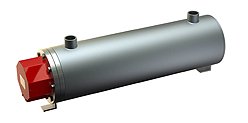Electric Immersion Heaters in Industrial Storage Tanks
This case study looks at electric immersion heaters in industrial storage tanks and what sensors are required to prevent freezing or fire damage.
Introduction: Storage Tank Freeze Protection
In this case study, we will look at a wastewater and desalinization processing plant in Alaska, where winter lasts 6 months and the average annual temperature is 37°F or 2.78°C. This plant can produce between 30,000 and 100,000 m3 per day. The processing plant wants three 8000-gallon storage tanks to house treated water before it is piped to a local mining operations to control dust. Temperatures in the tanks and pipes must be maintained above freezing and water levels must be monitored to prevent fire damage to tank linings.
Storage tank freeze protection is essential when dealing with storage tanks. To help combat this problem, immersion heaters with storage tank control sensors must be utilized to maintain temperatures and monitor water levels.
Background for the Case Study
 Each tank will require electric immersion heaters to prevent freezing and maintain a steady 37°F, as requested by management to meet the average local temperatures and reduce energy waste. These three tanks will also require sensors capable of remote monitoring of temperature and water levels to ensure the heaters are shielded from reduced water levels that would expose the heaters, possibly leading to damage from burnout.
Each tank will require electric immersion heaters to prevent freezing and maintain a steady 37°F, as requested by management to meet the average local temperatures and reduce energy waste. These three tanks will also require sensors capable of remote monitoring of temperature and water levels to ensure the heaters are shielded from reduced water levels that would expose the heaters, possibly leading to damage from burnout.
Additionally, the pipes will need freeze protection when mining operations do not require dust control during maintenance and downtime. As long as the water is moving through the pipes, the water is unlikely to freeze; however, standing water is likely to freeze quickly in Alaska’s harsh temperatures.
Possible Solutions
Flanged heaters are available in a wide variety of sizes and can be configured to fit the tank and its size. This specific type of heater is installed via flange port with the heater being inserted via this port into the tank itself. Immersion heaters in industrial settings are very helpful at keeping liquids above freezing temperatures, particularly in very harsh winter weather where fluid freezes faster.Although Screw Plug immersion heaters are a possibility and can be monitored in the same manner as a flanged immersion heater, these are normally utilized in smaller tanks than the tanks being utilized to store the desalinized water. However, the screw plug immersion heater could be utilized in the pipelines with proper controls.
Hybrid temperature control panels provide increased reliability and greater flexibility. Flanged immersion heaters can be monitored and controlled with hybrid temperature control panels that offer an optional over/under temperature monitoring limits with alarms. These control panels have various configurations, which provide short circuit current ratings (SCCR) up to 200,000 amps. Additional sensors, such as water level monitors can be added in these hybrid control panels to provide more monitoring and alarms to guard against damage.
The disadvantage to using a digital control panel is the need for added training for operation and troubleshooting of the panel. However, that is a likely scenario with any added sensors.
Circulation heaters or “in-line heaters” can be disbursed throughout the pipeline to prevent freezing. These heaters use anti-corrosive materials such titanium, steel, or stainless steel, though stainless steel is most widely used with water. Additionally, the pipes should be insulated to ensure better efficiency of the circulation heaters. Thermocouples are used to transmit temperature readings from the pipes to digital sensors, which help regulate heat.
Pipe heaters could also be used. Pipe heaters produce indirect heat for the liquids. During heating procedures, a pipe heater does not contact the liquid content. Pipe heaters fit into the 2 or 3-inch horizontal schedule 40 nominal pipe size. The pipe heaters are easy to install and provide uniform heat distribution, as well as a prolonged service life.
Recommendations
Flanged heaters are recommended for use in the tanks for freeze protection, along with remote sensors for temperature control and water level monitoring using a hybrid temperature control panel, so that customizing is possible to provide digital output. These flanged immersion heaters should be made of stainless steel to impede corrosion. Furthermore, the flanged immersion heaters can be customized to the appropriate wattage required. Electric flanged immersion heaters are a clean option in a “green” environment where wastewater recycling is being processed and the control sensors are a must to meet the plant’s requirements.
Additionally, pipe heaters tied into temperature sensors are recommended, since the required heating will be done while there is no circulation within the pipes.
